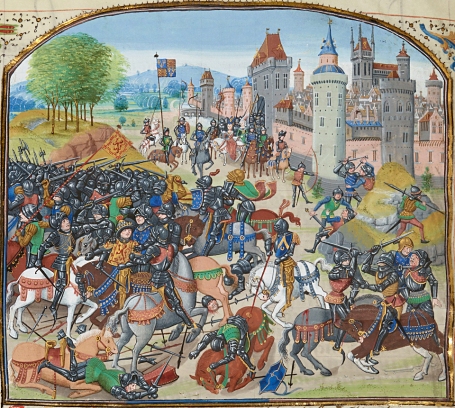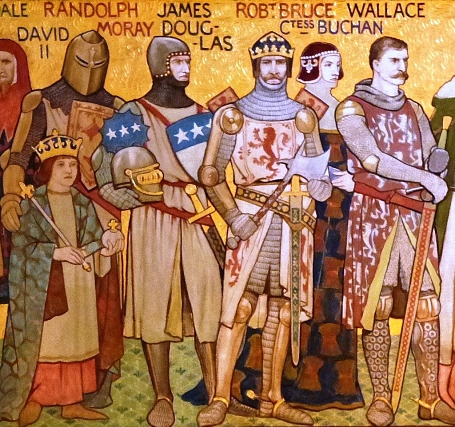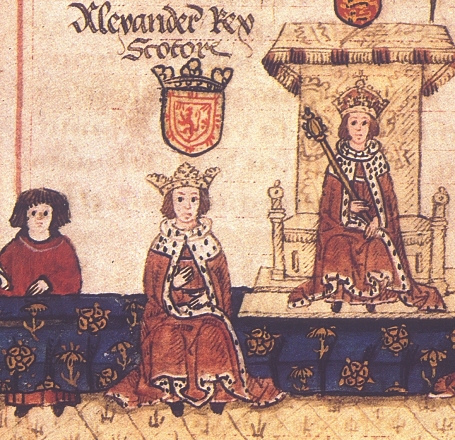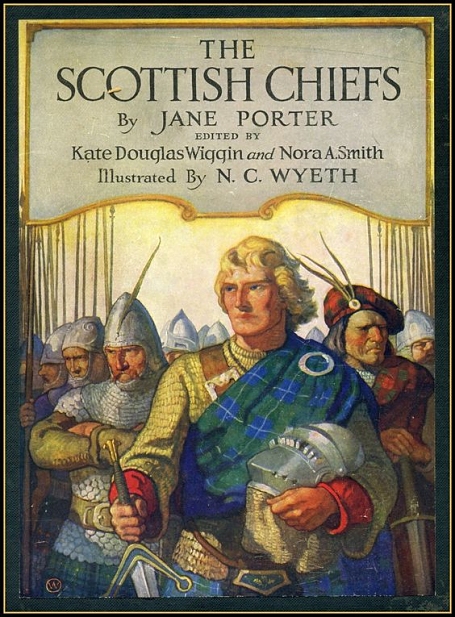The Life and Heroick Actions of the Renoun'd Sir William Wallace,
General and Governour of Scotland
by William Hamilton of Gilbertfield
Book II, Chapter III (Continued)
How WALLACE was imprisoned in Ayr, and escaped.
But Providence which Interposes oft,
Directs his Fall into a Place was soft;
His Nurse which liv'd in the New-Town of Ayr,
Hearing the News in haste came running there
And on her Knees with Face as pale as Clay,
Did purchase leave to bear his Corps away.
With Sorrow, him unto her House she bore,
Then with warm Water bath'd his Body o'er.
His Heart she found to flighter to and fro,
His Eyes at last they did cast up also.
Then on a Bed she laid him soft as Silk,
And suckled him with her own Daughters Milk.
Her love to him and tender Care was such,
In a short Time he did recover much.
Thus secretly she did him Nurse and Feed,
And made the Word still pass, that he was Dead.
She weeped sore in ev'ry Body's sight,
Till he became both able stout and tight.
Thomas the Rhymer at that very Time,
Who prophecy'd in Ancient Scottish Rhyme,
In vulgar Estimation not the least,
Did pay a Visit to the Parish-Priest:
Whose Servant, had just at the Mercate been,
And what befel poor Wallace there, had seen.
The Priest, does on his Servant quickly call,
"What News," said he. "Sir, few or none at all."
The Priest said that he never yet did know,
The Scots and English part without a Blow.
"Good Wallace," quoth the Lad; and shook his Head,
"I Saw them cast him ov'r the Wall for dead."
The Priest replyed with a heavy Heart,
"For that I hope to see the South'ron smart.
Wallace was Wight, and come of gentle Blood."
Thomas, he said the Tidings were not good.
The Priest said, "Surely they would foster Feud."
But Thomas said, that Wallace was not Dead.
The Servant told, he saw a Woman there,
That did belong to the New-Town of Ayr:
Upon her Knees from South'ron Purchase leave
To carry Wallace somewhere to his Grave.
Pensive a little, Thomas in his Thought,
"By God," said he, "that hath this World wrought,
And brings to pass each Thing for his own Glore,
If he be dead, Thomas shall live no more."
The honest Priest hearing him speak so plain,
He charg'd his Servant to return again,
To view the Woman's House, and carefully,
To look about, what he could hear or spy.
The Servant thus in haste is gone away,
Straight to the House, and Place where Wallace lay.
"Who's this lyes here," he did demand in plain.
The Woman rose in Sorrow, Grief, and Pain;
"The worthy Wallace, Oh!" replied she,
Then weeped sore, and very piteously.
She on her Knees did pray, for JESUS sake;
He would conceal, and no Discovery make.
The Servant answer'd with a fearful Oath,
That he to harm him would be very loath:
Might he on Life but see him with his Eyes,
He would rejoice or curs'd might he be Thrice.
She, to good Wallace led him up the Stairs,
There saw him gladly, and he back Repairs:
To Thomas, and his Master, who attend
To hear the Story all, from End to End.
He told them, the first Tidings were a Lie,
Then Thomas said, "Before that Wallace die,
Out of this Land he shall the South'ron send,
And Thousands on the Field make their last End.
He Scotland Thrice shall bring into great Peace,
And South'ron ay be frighted at his Face."
Then cheer up Scots, cast from you Care and Sloath,
And pray believe what Thomas says is Truth.
When Wallace Actions we to light produce,
We'll find him not Inferior to Bruce:
But 'cause the Bruce, was of our Kingdom Heir,
Wallace therefore with him we'll not compare.
Yet by his Courage, and his Conduct wise,
As we have heard, he rescu'd Scotland thrice.
Unto the Nation's universal Joy,
The Time he was the Baliol's Viceroy.
The ballad, The Life and Heroick Actions of the Renoun'd Sir William Wallace, General and Governour of Scotland, by William Hamilton of Gilbertfield, 1722, is in the public domain.

The Kingdom of England and the Kingdom of Scotland fought dozens of battles with each other. They fought typically over land, particularly Berwick-Upon-Tweed, and the Anglo-Scottish border frequently changed as a result. Read more at Wikipedia.

The First War of Scottish Independence was the initial chapter of engagements in a series of warring periods between English and Scottish forces lasting from the invasion by England in 1296 ... Read more at Wikipedia.

Edward I (1239-1307), also known as Edward Longshanks and the Hammer of the Scots, was King of England from 1272 to 1307. Read more at Wikipedia.

Digitized version of The Scottish Chiefs, by Jane Porter, a novelization published in 1921 by Charles Scribner's Sons, about William Wallace and the First Scottish War of Independence. Read online at archive.org.